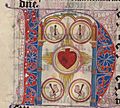Heart (symbol) facts for kids
The heart symbol is a well-known shape. It is used to show affection or love, especially romantic love. When you see a heart symbol that looks wounded, like it's pierced with an arrow or broken, it means someone is feeling lovesickness or sadness because of love.
Contents
The Heart Symbol: What It Means
The heart symbol is one of the most recognized shapes in the world. It stands for feelings like love, passion, and friendship. People use it on cards, gifts, and messages to show they care.
Why a Heart Shape?
The symbol we use today doesn't look exactly like a real human heart. It's thought that the shape might have come from different ideas over time. Some believe it could be inspired by the shape of certain leaves, like ivy, or even the shape of the human heart as people imagined it long ago.
Heart Symbols in History
The heart symbol has been around for a very long time.
Early Uses of the Heart Symbol
- In ancient times, symbols that looked like hearts were sometimes used in art. For example, some ancient coins from a place called Cyrene, Libya showed a heart-shaped seed from a plant called silphium. This plant was important to them.
- One of the earliest known times the heart symbol was used to mean love was in the 13th century. In a French story called the Roman de la poire, a lover gives his heart to a lady. This was shown in a picture, which might be the first time we see the symbol used this way.
Hearts in Art and Religion
- During the Middle Ages, artists started using the heart symbol more often. You can see it in paintings and sculptures.
- For example, in the 14th century, the artist Giotto showed a figure of Charity giving her heart to Jesus. This showed how love and kindness were important.
- The heart also became important in religious art, especially for the Sacred Heart of Jesus. This symbol often shows a heart with flames or a cross, representing divine love.
Hearts in Everyday Life
- By the 15th and 16th centuries, the heart symbol became even more popular. It appeared in books, on playing cards, and in special love letters.
- The famous Luther rose, designed in 1530, includes a black cross inside a red heart, showing faith and love.
- The Danish "Heart Book" from the 1550s was a collection of love songs written in a heart-shaped book!
Hearts in Modern Times
Today, the heart symbol is everywhere.
- It's a main part of Valentine's Day cards and decorations.
- It's used in emojis and digital messages to quickly show feelings.
- Wedding rings often have heart shapes or are exchanged as a symbol of love.
The heart symbol continues to be a powerful way to express love, friendship, and care across cultures and generations.
Images for kids
-
The chanson Belle, Bonne, Sage by Baude Cordier, written in the shape of a heart, in the Chantilly Codex. This is one of two dedicatory pieces placed at the beginning of the older (late 14th century) corpus, probably to replace the original first fascicle, which is missing.
-
Augustine of Hippo holding a heart in his hand which is set alight by a ray emanating from divine Truth (Veritas), painting by Philippe de Champaigne, c. 1650.
-
Allegorical painting of the Sacred Heart of Jesus. The central heart radiates hearts gathered up by Putti. By Robert la Longe, c. 1705.
-
18th-century depiction of the Sacred Heart from the vision of Marguerite Marie Alacoque (d. 1690). The heart is both "heart shaped" and drawn anatomically correct, with both the aorta and the pulmonary artery visible, with the crucifix placed inside the aorta.
-
Two burning hearts, coloured pink, illustration on a Victorian-era Valentine's Day card.
-
Ancient silver coin from Cyrene, Libya depicting the heart-shaped 'seed' (actually fruit) of silphium.
-
Example of a heart-shaped mericarp fruit in a plant (Heracleum sphondylium) belonging, like the unidentified silphium, to the parsley family, Apiaceae.
See also
 In Spanish: Corazón (símbolo) para niños
In Spanish: Corazón (símbolo) para niños































